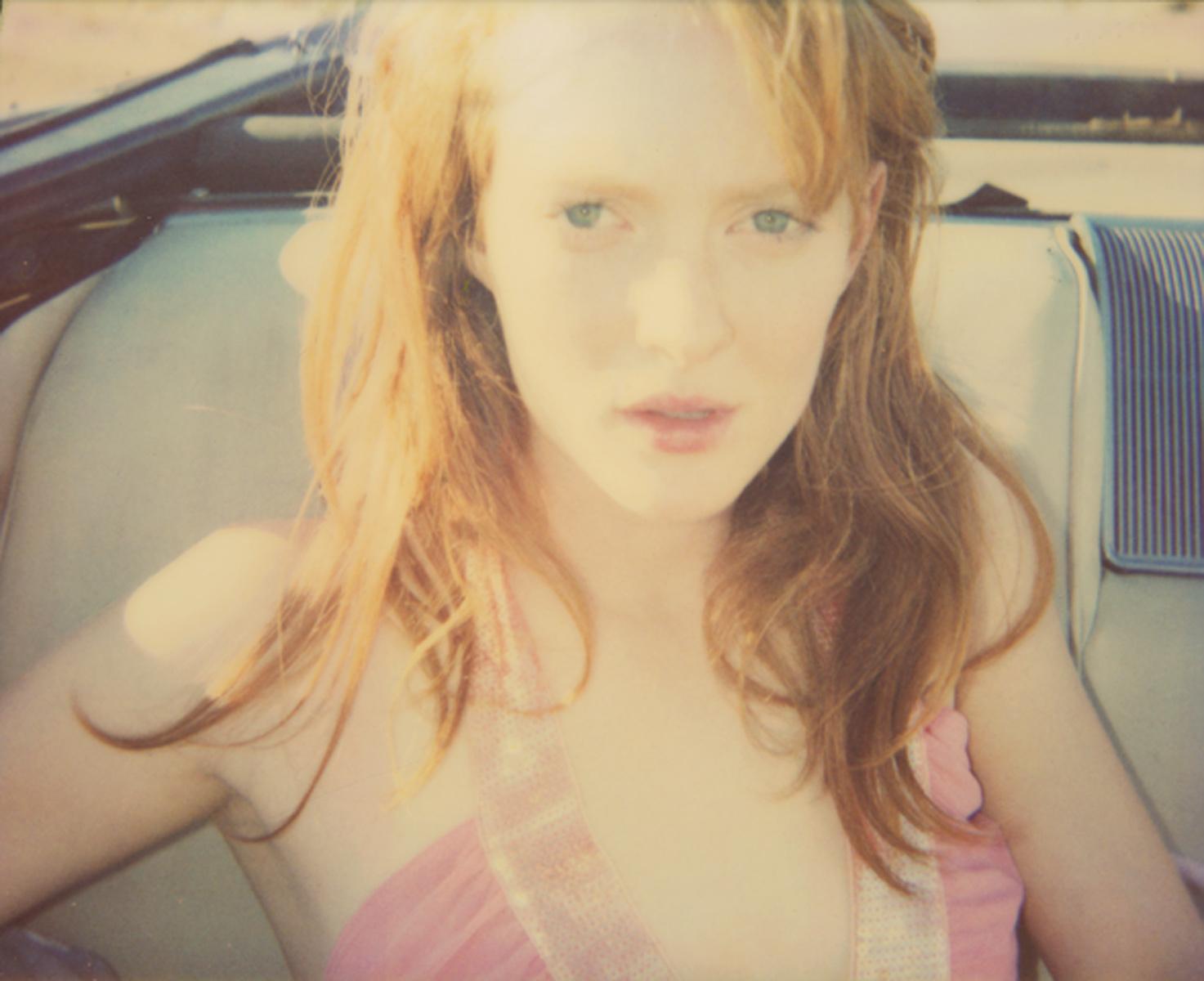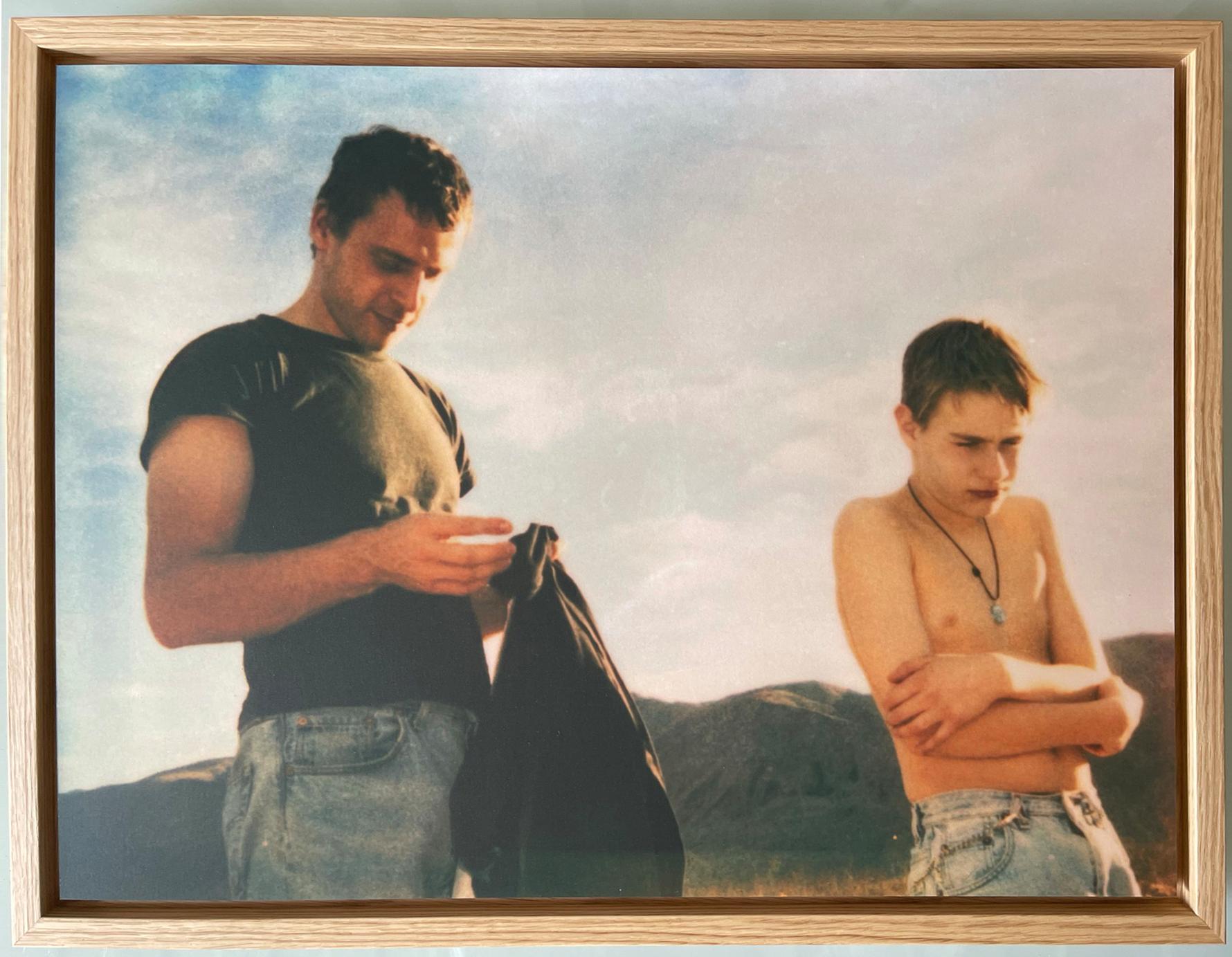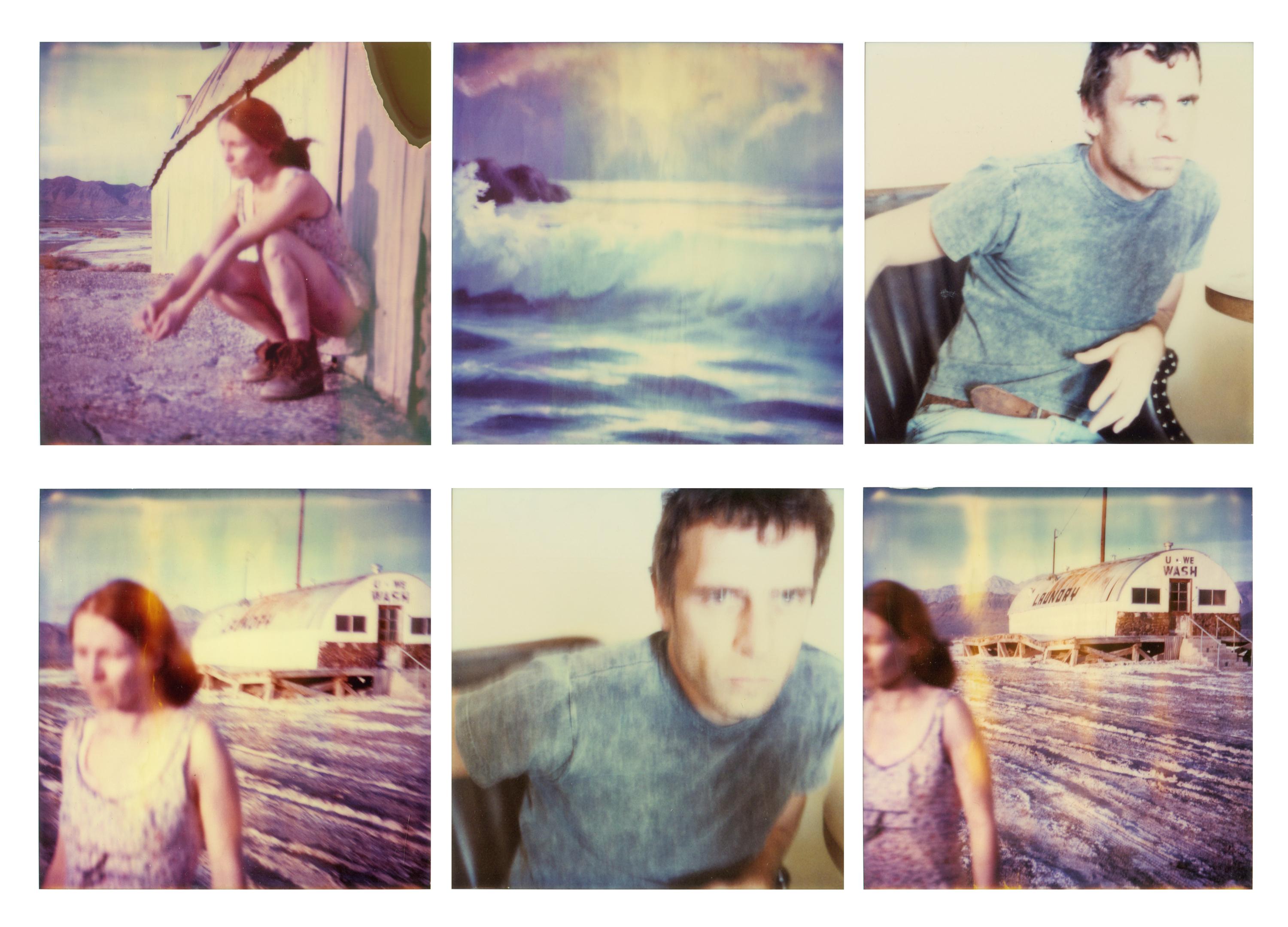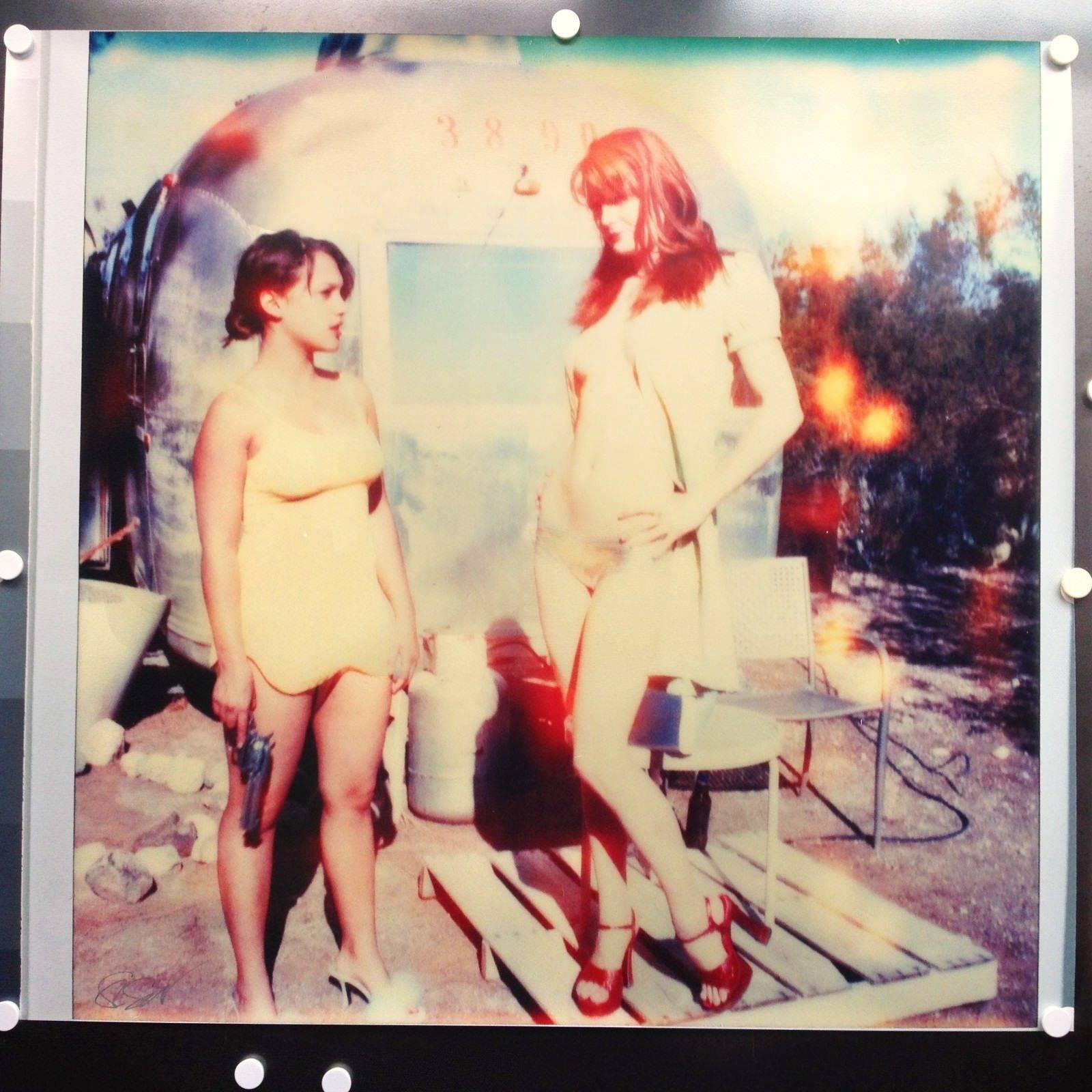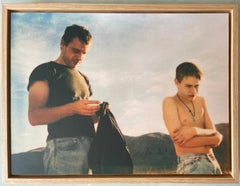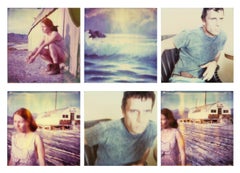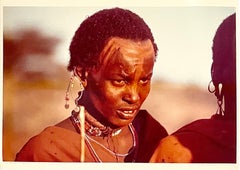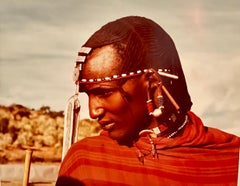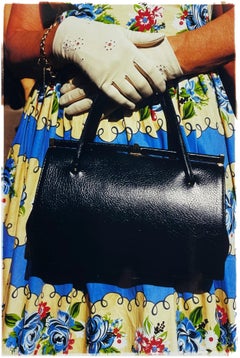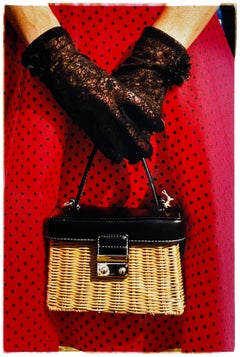Items Similar to Long Way Home II with Radha Mitchell and Max Sharam
Want more images or videos?
Request additional images or videos from the seller
1 of 2
Stefanie SchneiderLong Way Home II with Radha Mitchell and Max Sharam1999
1999
About the Item
'Long Way Home II' (Stranger than Paradise) - 1999
20x20cm, Edition 6/10
digital C-Print based on a Polaroid,
Signature label and Certificate,
Not mounted.
Models: Radha Mitchell and Max Sharam
Stefanie Schneider enlarges expired Polaroid stock into burned-out C-prints. The glossy images almost completely dissolve into lurid color abstractions. The shiny pink of a sex kitten's glittery body suit becomes an electrified, free-floating color field. The vivid, flame-orange hair of a 70's sexploitation film star vibrates against the dusty gray of the sky above an LA desert. Skin tones and facial details in the figures are completely lost. They are refugees from Faster Pussycat Kill Kill, doomed to aimlessly wander in a burned out celluloid limbo.
Schneider's process is one of reflexive inversion. She stages her scenes and shoots them with expired Polaroid film, producing a decayed positive. The decay keeps the image from being a true positive, creating a hybrid: a positive with negative traits: burned out light values, super saturated colors, lost information. The Polaroid is then re-photographed, producing a negative. This negative, one imagines, is more compelling than the finished work. It must be filled with a deep, rich darkness and luminous color.
The negative enlarges and duplicates the original Polaroid as a C-print, preserving the decay as an archival photograph. Schneider's process creates a circuit between ideas of preservation and decay. Her work emerges from the loop unsettled. The final C-prints are windows into a fluctuating limbo. They depict actors and environments neither here nor there; neither completely fictional nor completely real, and the information needed to make a decision in this regard is lost; burned away.
The viewer is left sifting through broken artifacts and assembling scraps of imagery. The strength of this work is the opportunity it provides the viewer. Although the decayed images are visually unsatisfying, they are cognitively spacious. The burned out highlights are also blank areas in which the observer can re-build lost narratives. Schneider eschews the authoritative power of the art object and instead prolongs the life of damaged, uncertain images.
The figures themselves seem to cling to existence through pure, unabated, fashion-conscious ferocity. Instead of possessing a complex, human identity, they are reduced to flattened neon hyper-vixens baring their teeth and their substantial cleavage in the scathing sun of a SoCal desert. They brandish squirt guns as sexual weaponry and sneer behind gigantic insectoid sun glasses. The stupid brutality of these misguided archetypes of feminine power is eased by the delicacy of their disappearance. They are images of vaguely remembered freaked-out alter egos, the noble heroes of Gloria Steinem's too-much-pizza-and-beer nightmares.
Often, our nightmares are the best remembered. Pleasant dreams mix too easily with sleep. Nightmares are dislocating. We toss and turn and separate our mind into a dreaming part and a part that is strangely aware. Questions generated by a partition of consciousness float through the dream experience itself. Am I dreaming now? We hear this even as we are in the midst of performing some alien task within the story line of the dream, and somehow, we accept the schism.
Schneider operates within this gap. Are these photographs of photographs real photographs? Is Schneider's final product simply an archive of the source Polaroid? Her costumed actors recreate scenes from D-grade 70's sexploitation films. Schneider wraps these unconvincing fictions in yet another layer of fiction, and we are unable to sustain whatever small suspension of disbelief we had engaged watching Faster Pussycat.
This is Schneider's true subject. What happens when fictions evaporate? What traces are left after the disappearance of something whose ties to the real were tenuous to begin with? What do ghosts turn into when they die? Schneider recreates and decays fictions that perhaps weren't worth preserving in the first place, as a negative of a negative.
article portlandart by Y Isaac Peterson
Stefanie Schneider received her MFA in Communication Design at the Folkwang Schule Essen, Germany. Her work has been shown at the Museum for Photography, Braunschweig, Museum für Kommunikation, Berlin, the Institut für Neue Medien, Frankfurt, the Nassauischer Kunstverein, Wiesbaden, Kunstverein Bielefeld, Museum für Moderne Kunst Passau, Les Rencontres d'Arles, Foto -Triennale Esslingen.
- Creator:Stefanie Schneider (1968, German)
- Creation Year:1999
- Dimensions:Height: 7.88 in (20 cm)Width: 7.88 in (20 cm)Depth: 0.04 in (1 mm)
- Medium:
- Movement & Style:
- Period:
- Condition:
- Gallery Location:Morongo Valley, CA
- Reference Number:1stDibs: LU65238020542
Stefanie Schneider
Stefanie Schneider received her MFA in Communication Design at the Folkwang Schule Essen, Germany. Her work has been shown at the Museum for Photography, Braunschweig, Museum für Kommunikation, Berlin, the Institut für Neue Medien, Frankfurt, the Nassauischer Kunstverein, Wiesbaden, Kunstverein Bielefeld, Museum für Moderne Kunst Passau, Les Rencontres d'Arles, Foto -Triennale Esslingen., Bombay Beach Biennale 2018, 2019.
About the Seller
4.9
Platinum Seller
Premium sellers with a 4.7+ rating and 24-hour response times
Established in 1996
1stDibs seller since 2017
1,019 sales on 1stDibs
Typical response time: 2 hours
- ShippingRetrieving quote...Shipping from: Morongo Valley, CA
- Return Policy
Authenticity Guarantee
In the unlikely event there’s an issue with an item’s authenticity, contact us within 1 year for a full refund. DetailsMoney-Back Guarantee
If your item is not as described, is damaged in transit, or does not arrive, contact us within 7 days for a full refund. Details24-Hour Cancellation
You have a 24-hour grace period in which to reconsider your purchase, with no questions asked.Vetted Professional Sellers
Our world-class sellers must adhere to strict standards for service and quality, maintaining the integrity of our listings.Price-Match Guarantee
If you find that a seller listed the same item for a lower price elsewhere, we’ll match it.Trusted Global Delivery
Our best-in-class carrier network provides specialized shipping options worldwide, including custom delivery.More From This Seller
View AllThe Trick Is To Keep Breathing - Polaroid, Contemporary, Environmental, Future
By Julia Beyer
Located in Morongo Valley, CA
'The Trick is to keep Breathing’, 2017,
10x20 inches, edition 1/10, Metal Print, high gloss, based on a Mixed Media Polaroid diptych. Signature label with Certificate.
Exhibition:...
Category
2010s Contemporary Color Photography
Materials
C Print, Photographic Paper, Color, Polaroid
Mermaid's Daughter (Till Death do us Part)
By Stefanie Schneider
Located in Morongo Valley, CA
Mermaid's Daughter (Till Death do us Part) - 2005,
70x85cm,
Edition of 10.
Archival C-Print, based on the original Polaroid.
Certificate and Signature label.
Artist Inventory ...
Category
Early 2000s Contemporary Color Photography
Materials
Archival Paper, Photographic Paper, C Print, Color, Polaroid
D. and Felix - Contemporary, 21st Century, Polaroid, Figurative Photography
By Stefanie Schneider
Located in Morongo Valley, CA
D. and Felix (Stranger than Paradise) - 1997
Edition of 2/30.
Image size 16 x 21.6 inch,
External dimensions: 17.7 x 23.3 inch.
Archival C-Print, based on the Polaroid.
Mounted...
Category
1990s Contemporary Portrait Photography
Materials
Photographic Paper, C Print, Polaroid, Wood, Archival Paper
Alaska (Stranger than Paradise) analog - 6 pieces
By Stefanie Schneider
Located in Morongo Valley, CA
Alaska (Stranger than Paradise) - 2002
Edition of 3/5,
105x150cm installed, 48x46 cm each.
6 Analog C-Prints, hand printed by the artist and based original 6 Polaroids.
Signature...
Category
Early 2000s Contemporary Color Photography
Materials
Archival Paper, Photographic Paper, C Print, Color, Polaroid
Untitled (Oilfields) - Contemporary, Polaroid, Photograph, Analog, Enlargement
By Stefanie Schneider
Located in Morongo Valley, CA
Untitled (Oilfields) - 2004
60x60cm,
Edition 2/10,
analog C-Print, hand-printed by the artist,
based on a Polaroid.
Certificate and Signature label,
artist Inventory No. 1220.0...
Category
Early 2000s Contemporary Portrait Photography
Materials
Archival Paper, Photographic Paper, C Print, Color, Polaroid
Daisy and Austen in front of Trailer - based on a Polaroid Original - Proof
By Stefanie Schneider
Located in Morongo Valley, CA
Daisy and Austen in front of Trailer (Till Death do us Part) - 2005
Proof b4 Printing / 128x125cm
signed, analog C-Print, hand-printed by the artist, based on a Polaroid,
signed on...
Category
Early 2000s Contemporary Color Photography
Materials
Archival Paper, Photographic Paper, C Print, Color, Polaroid
You May Also Like
Rare Vintage Color C Print Photograph African Maasai Warrior Chromogenic Photo
By Carol Beckwith
Located in Surfside, FL
Carol Beckwith, (American, b. 1945),
Maasai Portrait
Chromogenic print on paper, from Beckwith's book "Maasai" (1980),
Hand signed in pencil, dated and titled with name of sitter in margins,
19" x 16" Sheet.
Carol Beckwith (1945-) is an American photographer, author, and artist known for her photojournalism documenting the indigenous tribal cultures of Africa, most notably in partnership with the Australian photographer Angela Fisher. Between them, Beckwith and Fisher have published 14 books, and have had their photos appear in National Geographic, Natural History, African Arts, The Observer Magazine, Time, Life, Vogue, Marie Claire and Elle.
They continue to exhibit and lecture at galleries and museums worldwide, including The American Museum of Natural History and The Explorers Club in New York City, The Smithsonian Institution in Washington, DC, and the Royal Geographical Society in London. They have also collaborated on four films about African traditions. Together they have received numerous accolades, including the United Nations Award for Excellence, the Royal Geographical Society's Cherry Kearton Medal, two Anisfield-Wolf Book Awards, The Explorers Club Lowell Thomas Award, and the WINGS WorldQuest Lifetime Achievement Award.
Carol Beckwith was born in Boston, Massachusetts, where she went on to attend both the School of the Museum of Fine Arts, Boston and Goucher College in Maryland. After obtaining her degree in Painting and Photography she won a traveling fellowship from the Boston Museum, which let her travel to other countries for the first time.
She spent seven months in Japan, living in a Zen temple and studying calligraphy painting. She continued to travel through Southeast Asia and New Guinea, where she witnessed a "sing-sing", a gathering of 90,000 Highland warriors, in Mount Hagen, and paddled up Chambri Lakes in a canoe, an experience she called "one of the most wonderful, and in a way formative, experiences in my life." Her first trip to Africa was in 1973, when she was invited to spend Christmas with a friend in Kenya. Beckwith bought a 45-day roundtrip ticket and ended up staying eight months. There she encountered the Maasai people who invited her to witness a female circumcision ceremony. Astonished by the ritual, she then determined to spend more time with the Maasai.
Beckwith studied photography in college but had initially intended to become a painter. It was during her travels through New Guinea that she realized the advantages of photography, saying that "there was such a vast amount of exciting material that I began to photograph instead, approaching photography with the eye of a painter in terms of light, color, composition. I wanted the images to be multi layered experiences in a way that a painting is. . . [Photography] seemed to be a more suitable medium for the pace of travel."
Beckwith's first major collaboration was with Tepilit Ole Saitoti, an anthropologist and former Maasai warrior...
Category
1970s Contemporary Color Photography
Materials
C Print, Photographic Paper
Rare Vintage Color C Print Photograph African Maasai Warrior Chromogenic Photo
By Carol Beckwith
Located in Surfside, FL
Carol Beckwith, (American, b. 1945),
Maasai Portrait
Chromogenic print on paper, from Beckwith's book "Maasai" (1980),
Hand signed in pencil, dated and titled with name of sitter in margins,
19" x 16" Sheet.
Carol Beckwith (1945-) is an American photographer, author, and artist known for her photojournalism documenting the indigenous tribal cultures of Africa, most notably in partnership with the Australian photographer Angela Fisher. Between them, Beckwith and Fisher have published 14 books, and have had their photos appear in National Geographic, Natural History, African Arts, The Observer Magazine, Time, Life, Vogue, Marie Claire and Elle.
They continue to exhibit and lecture at galleries and museums worldwide, including The American Museum of Natural History and The Explorers Club in New York City, The Smithsonian Institution in Washington, DC, and the Royal Geographical Society in London. They have also collaborated on four films about African traditions. Together they have received numerous accolades, including the United Nations Award for Excellence, the Royal Geographical Society's Cherry Kearton Medal, two Anisfield-Wolf Book Awards, The Explorers Club Lowell Thomas Award, and the WINGS WorldQuest Lifetime Achievement Award.
Carol Beckwith was born in Boston, Massachusetts, where she went on to attend both the School of the Museum of Fine Arts, Boston and Goucher College in Maryland. After obtaining her degree in Painting and Photography she won a traveling fellowship from the Boston Museum, which let her travel to other countries for the first time.
She spent seven months in Japan, living in a Zen temple and studying calligraphy painting. She continued to travel through Southeast Asia and New Guinea, where she witnessed a "sing-sing", a gathering of 90,000 Highland warriors, in Mount Hagen, and paddled up Chambri Lakes in a canoe, an experience she called "one of the most wonderful, and in a way formative, experiences in my life." Her first trip to Africa was in 1973, when she was invited to spend Christmas with a friend in Kenya. Beckwith bought a 45-day roundtrip ticket and ended up staying eight months. There she encountered the Maasai people who invited her to witness a female circumcision ceremony. Astonished by the ritual, she then determined to spend more time with the Maasai.
Beckwith studied photography in college but had initially intended to become a painter. It was during her travels through New Guinea that she realized the advantages of photography, saying that "there was such a vast amount of exciting material that I began to photograph instead, approaching photography with the eye of a painter in terms of light, color, composition. I wanted the images to be multi layered experiences in a way that a painting is. . . [Photography] seemed to be a more suitable medium for the pace of travel."
Beckwith's first major collaboration was with Tepilit Ole Saitoti, an anthropologist and former Maasai warrior...
Category
1970s Contemporary Color Photography
Materials
C Print, Photographic Paper
Floral Striped Dress, Goodwood Revival - Vintage Fashion Photograph
By Richard Heeps
Located in Cambridge, GB
This stylish artwork, 'Floral Striped Dress' taken at the glamorous retro event Goodwood Revival, perfectly captures feminine sophistication with a vintage vibe.
This artwork is a l...
Category
21st Century and Contemporary Contemporary Color Photography
Materials
C Print, Photographic Paper, Color, Silver Gelatin
Red Polka Dot Dress, Goodwood Revival - Vintage Fashion Photograph
By Richard Heeps
Located in Cambridge, GB
This stylish artwork, 'Red Polka Dot Dress' taken at the glamorous retro event Goodwood Revival, perfectly captures feminine sophistication with a ...
Category
21st Century and Contemporary Contemporary Color Photography
Materials
C Print, Photographic Paper, Color, Silver Gelatin
Floral Wicker Bag, Goodwood Revival - Vintage Fashion Photograph
By Richard Heeps
Located in Cambridge, GB
This stylish artwork, 'Floral Wicker Handbag' taken at the glamorous retro event Goodwood Revival, perfectly captures feminine sophistication with a vintage vibe.
This artwork is a ...
Category
21st Century and Contemporary Contemporary Color Photography
Materials
C Print, Photographic Paper, Color, Silver Gelatin
Red Polka Dot Dress, Goodwood Revival - Vintage Fashion Photograph
By Richard Heeps
Located in Cambridge, GB
This stylish artwork, 'Red Polka Dot Dress' taken at the glamorous retro event Goodwood Revival, perfectly captures feminine sophistication with a ...
Category
21st Century and Contemporary Contemporary Color Photography
Materials
C Print, Photographic Paper, Color, Silver Gelatin
Recently Viewed
View AllMore Ways To Browse
Vintage Home Products
Suspension Vintage Orange
Vintage Fur Wrap
Pink Sun Glasses
Dior Pink Watch
Dior Kitten
Vintage Poster Istanbul
Vintage Seville Poster
Vintage Siamese Cat Painting
Vintage Three Wise Monkeys
Vintage Travel Posters St Moritz
Vintage X Files Poster
Voulkos Monotypes
Walasse Ting Geisha
Warhol Basquiat Boxing
Warhol Endangered Species
Warhol Superman
Warhol Witch
